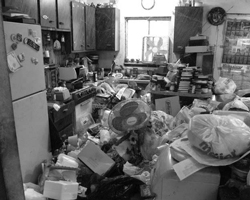The Disease Behind A&E’s “Hoarders”
 Many people collect things such as coins, dolls, baseball cards, and antique items. Keeping a collection clean and organized allows the individual to enjoy the items they have acquired. However, some people begin to collect things compulsively, and it consumes them.
Many people collect things such as coins, dolls, baseball cards, and antique items. Keeping a collection clean and organized allows the individual to enjoy the items they have acquired. However, some people begin to collect things compulsively, and it consumes them.
If this behavior continues unchecked, and a home is filled with useless items that are unorganized and unkept, it is most likely a hoarding situation.
The A&E television show “Hoarders” addresses the issue of compulsive hoarding and assists the participants on the show in recognizing, cleaning up and receiving treatment for their disorder.
Compulsive hoarding is defined as “an irresistible desire to possess an extraordinary amount of items that, to others, may seem to have absolutely no value at all,” according to The Compulsive Hoarding Cure’s website.
In one episode, Andrew’s home is completely filled with stuff to the point the house is unlivable.
The hoard has spread to consume the entire property and he has a homeless man living in his front yard. His furnace no longer works, there is no running water, and the town is threatening to remove him from the home. After the show, he refused after-care treatment and the town did remove him. As a consequence to his hoarding, Andrew ended up homeless before he would part with his hoard.
The homes portrayed on the series show houses filled with garbage, boxes, food, newspapers, clothes or even animals. Michele Inzelbuch, a co-occurring counselor for addiction and mental health and graduate student at the University, said that keeping and collecting things takes precedence over everything else in a hoarder’s life. Regardless of ill health effects, financial problems or family member concerns, their compulsive disorder consumes their entire life.
Buried so deep in this disease, they need professional help to overcome this debilitating disorder.
Hoarders have an emotional attachment to their items and it becomes a part of who they are, Inzelbuch said. “It can be what keeps them motivated to stay alive. When you remove the objects of their obsession and compulsion they can see it as they have no reason to live.”
Classified as an obsessive-compulsive disorder, hoarding affects over three million Americans. Though many people may save and collect certain items, there are three distinct differences between owning a valuable collection and compulsive hoarding, according to The Compulsive Hoarding Center’s website.
When people save items, they generally use them and if they do not, they throw them away. Hoarders will keep these items even though they have no practical use or value.
People who have collections such as dolls or books usually have them systematically organized where as a hoarder allows things to pile up so they can no longer use them. Saving an item for its memorable value and keeping it in its proper place is what most people do. In contrast, a hoarder feels that if they get rid of an item, the memory attached to it will be lost.
The roots of this disorder stem from anxiety. Many times, the hoarding is set off by a traumatic event and the hoarder tries to fill the void, Inzelbuch said. The death of a loved one, the end of a significant relationship, or the loss of a job can trigger hoarding.
Belinda threatened to leave her husband and 14-year-old daughter if their home was not cleaned out from their hoarding. Belinda had suffered a back injury seven years prior to the episode. She said, “When I got sick, my house got sick.” She used to keep a clean house before her injury.
Once the crew came in to help clean up, Belinda’s anxiety level rose and she had trouble parting with anything.
The reality that she is the lead hoarder is revealed and her daughter, Shania, showed great frustration with her mother’s slow progress. Belinda even told Shania to keep things she wants to donate.
With her daughter’s motivation, Belinda does finally begin to let things go and they managed to clean the house up. The entire family continued to attend therapy after the show.
Thomas McCarthy, University counselor, said, “The thought of discarding an item is so overwhelming and anxiety provoking that keeping the item is the only way to eliminate the discomfort. This becomes a pattern over time, and the person has so many items and so much clutter that their living space is disrupted, or is unhealthy and unlivable.”
Some of the influencing factors aside from anxiety and trauma are compulsive shopping, disorganization, fear of waste, indecisiveness, and fear of losing important information. These symptoms can be addressed when someone reaches out for help.
There is hope for hoarders, as the show demonstrates in each episode, but they need the willingness to get better. “They have to be involved in the decision making,” Inzelbuch said.
“If you go into a hoarder’s house and you clean out the objects of their compulsion and they’re not participating in it, it will just get replaced and probably quicker than it was the first time.”
According to McCarthy, some of the techniques that help hoarders recover are the use of anti-depressants, exposure therapy, and Cognitive-Behavioral Therapy (CBT). The recovery is an ongoing process, and it is important that the hoarder has a long-term plan for support and counseling.
PHOTO COURTESY of aetv.com


